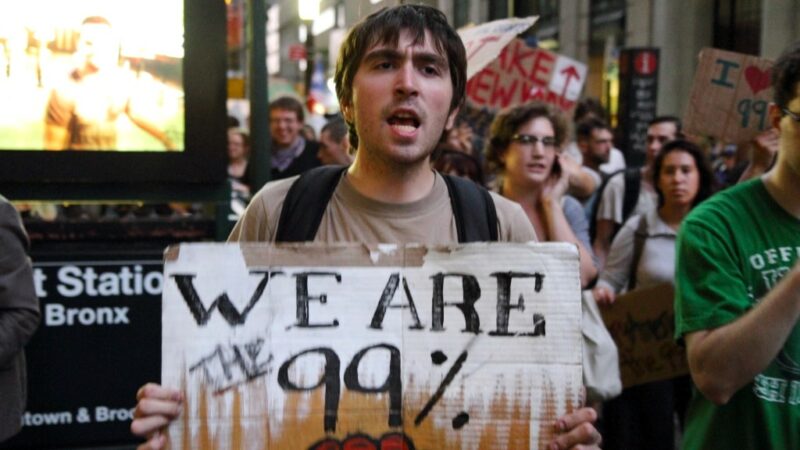 German Finance Minister Olaf Scholz in 2018 at the federal party conference of the Social Democratic Party (SPD). The COVID-19 pandemic makes the party conference slogan seem prophetic. A new chapter of interventionism began with his fiscal “Wham” (“Wumms”) or Go-Big policy announced in June 2020, which the German government would use to pull the country out of the crisis. (Image: Wikimedia Commons / Olaf Kosinsky)
German Finance Minister Olaf Scholz in 2018 at the federal party conference of the Social Democratic Party (SPD). The COVID-19 pandemic makes the party conference slogan seem prophetic. A new chapter of interventionism began with his fiscal “Wham” (“Wumms”) or Go-Big policy announced in June 2020, which the German government would use to pull the country out of the crisis. (Image: Wikimedia Commons / Olaf Kosinsky)
The Coronavirus crisis marks the steepest economic slump since the Federal Republic of Germany came into existence. The Kiel Institute for the World Economy estimates the loss of economic output in Germany for the two pandemic years 2020 and 2021 alone at over 340 billion euros. At the same time, around one million jobs have fallen victim to the economic consequences of the pandemic. These are severe losses.
The pandemic shock is comparatively easy to digest from an economic perspective. More lasting than the pandemic-related damage, policy-related defects are what threaten prosperity in this country.
But, as strange as it may sound at first, the pandemic shock is comparatively easy to digest from an economic perspective. More lasting than the pandemic-related damage, policy-related defects are what threaten prosperity in this country—and not just since SARS-CoV-2 has been in the world. By focusing much of the attention on the fight against the virus, not only has an overdue course correction been delayed, but in the wake of the crisis, the long march toward the interventionist state has advanced further. The associated costs make the pandemic much more expensive in the long run.
State Protection of Overall Economic Production Potential
In the course of the shutdown, economic activity was massively interrupted, but production structures were essentially not called into question (unlike in a financial crisis, in which previous undesirable developments are unleashed and it is difficult to correct them). In particular, this applies to the contact-intensive, consumer-related sectors such as tourism, restaurants, and entertainment, which were particularly hard hit during the shutdowns.
In such a situation, the primary task of economic policy is to get companies with viable business models through the lean shutdown period to protect the economy’s overall production potential. Efforts have been made in this direction, but the extent to which the various aid programs will be successful remains to be seen. Their bureaucratic design and false criteria (lump-sum subsidies, compensation for fixed costs, grants for lost revenues) raise serious doubts. In any case, targeted compensation for the equity erosion of the companies affected by the lockdown measures is still lacking.
Go-Big (“Wumms”) Policy: Were the Wrong Firms Saved?
At the same time, there are increasing signs that the aid has often saved the wrong firms—namely, those companies that were already in trouble before the crisis, while others have slipped through the cracks. This cannot be good for people’s willingness to engage in entrepreneurial activity in Germany. Moreover, the multiple readjustments have made life even more difficult for companies and their lenders, instead of counteracting the rampant uncertainty through stability policy.
Economic policy would have been well advised to orient its use of instruments— as well as the administrative capacity—based on a crisis assessment and specifically toward protecting viable entrepreneurial capital. There have been proposals to this end. It was clear very early on that private households would accumulate considerable purchasing power during the pandemic period because a substantial part of their usual spending is blocked during shutdown periods, while the tax and transfer system largely stabilizes incomes. Meanwhile, these additional savings are likely to amount to over 200 billion euros.
The problem was not the utilization of existing capacities due to a lack of demand, but their shutdown-induced idleness.
Thus, a lack of purchasing power is clearly no constraint on the post-pandemic recovery. From the outset, economic stimulus programs such as the 18 billion euro cut in value-added tax missed the problem posed by the crisis; the problem was not the underutilization of existing capacities due to a lack of demand, but their shutdown-induced idleness. As a result, this part of the go-big policy (“Wumms Politik,” lit., “wham policy”), announced by German Finance Minister Olaf Scholz in early June 2020, primarily benefited those whose business tended to pick up during the pandemic (for example, delivery businesses).
Fighting the Crisis as a Pretext for Industrial Policy Transformation Projects
With the assumption that ‘doing more is always better’ running rampant, further harm was done that will be felt beyond the pandemic period. It is a well-known political and economic pattern that in phases of severe economic crises, projects are (re)proposed that would never find majority support in normal times because they are too expensive. In an acute crisis, their costliness is turned into an advantage in accordance with the go-big logic as this provides welcome channels for additional government spending.
With the additional crisis-response label, dubious projects then become measures with supposed added macroeconomic value. Large parts of the “Future Package” adopted last year by the Federal Government in Germany and the so-called EU reconstruction program (“Next Generation EU”, NGEU) fall into this category. The measures contained therein do nothing to curb the crisis. Essentially, these are industrial and technology policy transformation projects that will only come to fruition after the pandemic has long been over. Thus, in the wake of crisis management, the amount of industrial policy intervention continues to increase.
Stabilization Policy and Structural Policy Are Two Different Things
Stabilization policy is by its very nature short-term oriented and aims to shore up existing capacities during a crisis phase. Structural policy can only ever be successful in the longer term and ideally does not operate with discretionary interventions, but with an adjustment of the regulatory framework within which economic actors adapt—with the aid of price signals. The European trading system for CO2 emission allowances is a successful example of such a policy approach. By forming corresponding market prices, CO2 emissions enter into the economic calculations of producers and consumers, who can then in turn look for solutions to reduce these costs, while the total amount of emissions is capped.
Climate protection subsidies that go beyond this, such as those contained in the crisis-response programs, come to nothing as regards the overall emissions target, because they only influence the prices for CO2 certificates. As a result, they only redistribute rents between the various actors. Before the COVID-19 crisis, this was obviously seen clearly—otherwise these programs could have been adopted long ago but were not for good reasons. The pandemic, however, does not provide any economic reason for such a change of course. These measures do not help in the crisis because the industries affected by shutdowns are not those that benefit from climate subsidies (or other technology policy programs).
The result is a crisis-response reflex to pursue a policy that neither stabilizes nor uses tools that make sense in terms of structural policy.
Because all countries have emerged from the crisis economically weakened, the structural leeway for government spending has not widened, but has narrowed considerably. The abrogation of fiscal rules (the debt brake in Germany and European fiscal pact at the EU level) explicitly applies only to the acute crisis phase, not to the period thereafter. The result is a crisis-response reflex to pursue a policy that neither stabilizes nor uses tools that make sense in terms of structural policy. Both are detrimental to production possibilities and, as a result, make people poorer beyond the consequences of the pandemic.
Serious Political Consequences at the EU-Level
At the level of the EU and the euro area in particular, the political consequences of the crisis response are even more serious because the regulatory framework has been further deformed. After the non-assistance clause had already fallen by the wayside in the European debt crisis, the ban on EU budget indebtedness was also thrown out during the COVID-19 crisis. The argument that this was a one-off exception is likely to prove ephemeral. It only conceals the fact that some member countries are so fiscally stressed that they had already lost unrestricted access to the capital market before the pandemic.
In Italy, a government has already broken up in the dispute over the use of EU funds, which is symptomatic of the real difficulties in the problem countries. For countries such as the Netherlands or Germany, the NGEU program means that they must now apply to the EU Commission for funds for which they themselves are guarantors, and which they could borrow on the capital market at any time, and have them checked by the Commission before they can spend them. This introduces an unnecessary fiscal layer that runs counter to the subsidiarity principle.
Overall, monetary policy is thus increasingly caught in the grip of fiscal dominance. The more highly indebted individual member countries are, the more susceptible they become to higher interest rates.
This policy does not solve the problem of over-indebted member states, but only defers it. In the same way, the same effect is reached by means of government monetary financing by the Eurosystem, which bought more government securities in the pandemic year 2020 than the euro member states had issued for their new net debt. This is the only reason why the creditworthiness certified by the rating agencies remained stable even in the highly indebted member countries. Overall, monetary policy is thus increasingly caught in the grip of fiscal dominance.
The more highly indebted individual member countries are, the more susceptible they become to higher interest rates, whether as a result of a general turnaround in interest rates (for example, in the wake of demographic change) or as a result of rising risk premiums. The central bank then has the choice between continued government financing via the printing press (even with higher inflation rates if necessary) or considerable distortions on the financial markets. The regulatory framework that was once supposed to protect against this problem is now so riddled with holes that the risks to monetary instability are greatly increasing.
A New Fiscal Regime through the Back Door?
The various instruments of joint liability (joint debt, monetary government financing) increase debt sustainability in the aggregate across all countries. But in so doing, they only delay the process of aggregate over-indebtedness. Instead of reversing the process, the COVID-19 crisis once again led to major steps in the wrong direction. Just as the European Financial Stability Facility (EFSF) became a permanent institution with the European Stability Mechanism (ESM), the new EU debt, declared as an exception, threatens to lead to a different fiscal regime. In addition to the misguided incentives, trust in the rule of law within the EU will also be damaged if central pillars of stability are repeatedly eroded with ad hoc measures in times of crisis without any changes to the treaties.
If we want a different regulatory framework, we should hold a broad public debate about it.
A regulatory framework should first and foremost help financial actors to form expectations. It must therefore be reliable, especially in times of crisis. If we want a different regulatory framework, we should hold a broad public debate about it and, depending on the outcome, either amend the EU treaties, or tackle the old debt problem and thus pave the way for a return to the stability order that was originally envisaged. Both are political feats of strength. Putting them off longer and longer may be the easiest (the most politically expedient) solution in the short term, but in the long term it will certainly be the most expensive in economic terms. The policy of sitting it out is not a solution, but the root cause of what has become a massive governance problem.
The Increasing State Grip on Economic Activity
“More of the same” is an unwise strategy, not only at the level of the EU and euro area, but also in German economic and fiscal policy. The state’s grip on economic activity has been increasing since the turn of the millennium. In the last year before the Corona-virus outbreak, the state’s revenue ratio reached a record high of 46.7 percent for Germany as a whole. The tax burden has been expanding with particular dynamism for some time, and the most recent reform has done little to change the high tax ratio.
Social security contributions have also been rising faster than incomes for several years now. At the same time, the serious consequences of demographic change will not really hit government finances until the next few years, a development that pension policy should have mitigated long ago. The redistribution conflicts in the 2020s will become fiercer. This is also because the low-interest phase combined with ultra-loose monetary policy has made life all too easy for finance ministers since the financial crisis. As a result, the government’s interest expenditure in relation to gross domestic product has fallen by almost two percentage points since then. This one-off effortless fiscal consolidation will not repeat itself.
Policymakers have become too accustomed to a way of operating in which new tasks are essentially met by additional spending, rather than rearranging priorities.
Meanwhile, policymakers have become too accustomed to a way of operating in which new tasks are essentially met by additional spending, rather than rearranging priorities. If one task moves up the target hierarchy, others must inevitably move down. The debate about the supposedly overly restrictive effect of the debt brake also suffers from this policy because the debt brake does not reduce the financing scope for the most important government expenditures, but for the least important ones. In particular, it does not prevent public investment. In 2019, for example, the government investment ratio (if this is anything to go by) was higher than at any time since the mid-1990s.
A Regulatory Compass Is Needed
The basic regulatory problem for policymakers can be described as Gulliver syndrome. Gulliver was held down not by a single thread, but by a whole web. It is similar with the influence of the government on economic activity—both in terms of regulatory density and fiscal spending. It is never a single regulation or spending project that reduces economic dynamism, but rather the sum of such measures, which by its sheer quantity threatens the quality of the economic order.
For example, a major new project that takes up two percent of economic output may seem attractive in its own right—fifty of such projects and, even theoretically, there is no longer a market economy. The practical limits, however, become significant much earlier. Instead of permanently testing this limit, what is needed is a policy that reestablishes a safe distance. This can only be done by working with market forces and not against them. This requires a regulatory compass—even, or especially, in times of crisis. Otherwise, with every crisis, we move further away from the goal we originally set out to achieve.
This article first appeared in German under the title “Außer Betrieb: Ordnungspolitischer Kompass – Wie Wirtschafts- und Finanzpolitik wieder in die Spur finden” (“Out of Order: Regulatory Compass—How Economic and Fiscal Policy Can Get Back on Track”) in the debate magazine CIVIS, (issue 1-2021, pp. 66-71).
Image: Olaf Kosinsky. Licence: CC BY-SA 3.0-en
Translated from German by Thomas and Kira Howes



